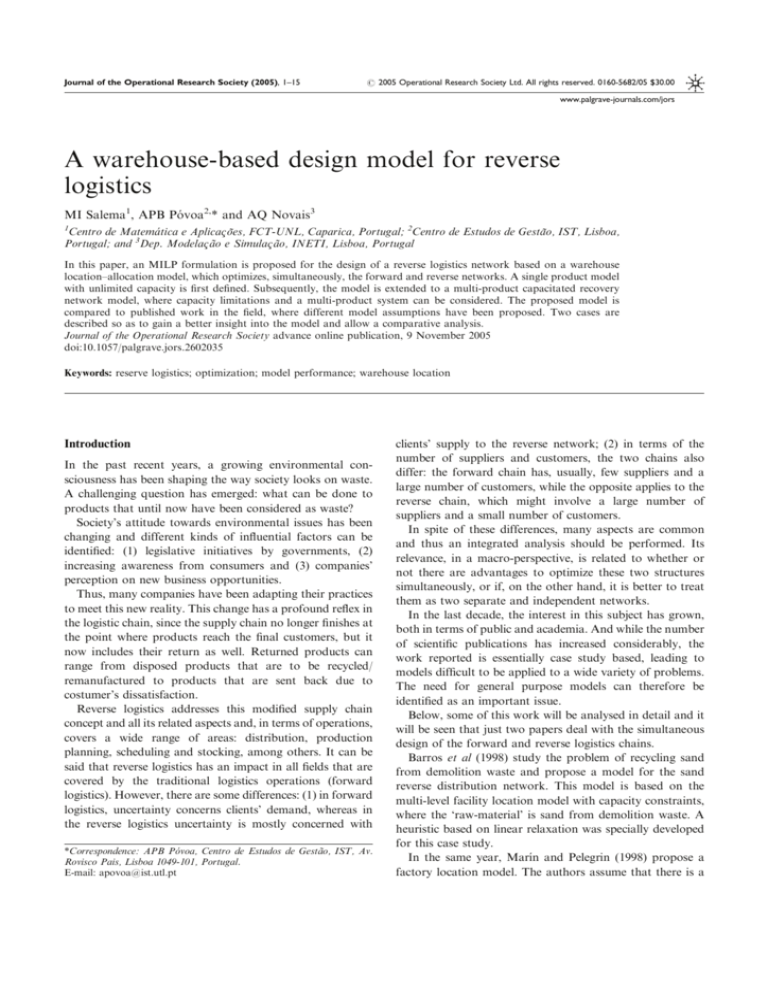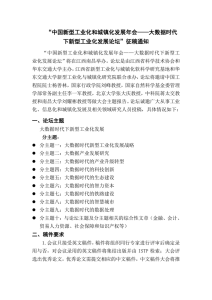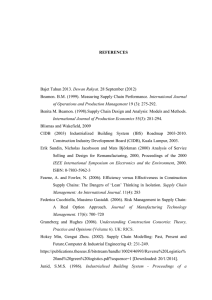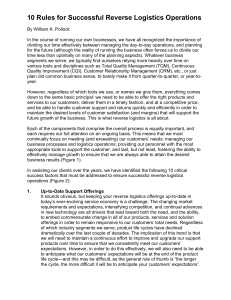
Journal of the Operational Research Society (2005), 1–15
r 2005 Operational Research Society Ltd. All rights reserved. 0160-5682/05 $30.00
www.palgrave-journals.com/jors
A warehouse-based design model for reverse
logistics
MI Salema1, APB Póvoa2,* and AQ Novais3
1
Centro de Matemática e Aplicac¸ões, FCT-UNL, Caparica, Portugal; 2Centro de Estudos de Gestão, IST, Lisboa,
Portugal; and 3Dep. Modelac¸ão e Simulac¸ão, INETI, Lisboa, Portugal
In this paper, an MILP formulation is proposed for the design of a reverse logistics network based on a warehouse
location–allocation model, which optimizes, simultaneously, the forward and reverse networks. A single product model
with unlimited capacity is first defined. Subsequently, the model is extended to a multi-product capacitated recovery
network model, where capacity limitations and a multi-product system can be considered. The proposed model is
compared to published work in the field, where different model assumptions have been proposed. Two cases are
described so as to gain a better insight into the model and allow a comparative analysis.
Journal of the Operational Research Society advance online publication, 9 November 2005
doi:10.1057/palgrave.jors.2602035
Keywords: reserve logistics; optimization; model performance; warehouse location
Introduction
In the past recent years, a growing environmental consciousness has been shaping the way society looks on waste.
A challenging question has emerged: what can be done to
products that until now have been considered as waste?
Society’s attitude towards environmental issues has been
changing and different kinds of influential factors can be
identified: (1) legislative initiatives by governments, (2)
increasing awareness from consumers and (3) companies’
perception on new business opportunities.
Thus, many companies have been adapting their practices
to meet this new reality. This change has a profound reflex in
the logistic chain, since the supply chain no longer finishes at
the point where products reach the final customers, but it
now includes their return as well. Returned products can
range from disposed products that are to be recycled/
remanufactured to products that are sent back due to
costumer’s dissatisfaction.
Reverse logistics addresses this modified supply chain
concept and all its related aspects and, in terms of operations,
covers a wide range of areas: distribution, production
planning, scheduling and stocking, among others. It can be
said that reverse logistics has an impact in all fields that are
covered by the traditional logistics operations (forward
logistics). However, there are some differences: (1) in forward
logistics, uncertainty concerns clients’ demand, whereas in
the reverse logistics uncertainty is mostly concerned with
*Correspondence: APB Póvoa, Centro de Estudos de Gestão, IST, Av.
Rovisco Pais, Lisboa 1049-101, Portugal.
E-mail: apovoa@ist.utl.pt
clients’ supply to the reverse network; (2) in terms of the
number of suppliers and customers, the two chains also
differ: the forward chain has, usually, few suppliers and a
large number of customers, while the opposite applies to the
reverse chain, which might involve a large number of
suppliers and a small number of customers.
In spite of these differences, many aspects are common
and thus an integrated analysis should be performed. Its
relevance, in a macro-perspective, is related to whether or
not there are advantages to optimize these two structures
simultaneously, or if, on the other hand, it is better to treat
them as two separate and independent networks.
In the last decade, the interest in this subject has grown,
both in terms of public and academia. And while the number
of scientific publications has increased considerably, the
work reported is essentially case study based, leading to
models difficult to be applied to a wide variety of problems.
The need for general purpose models can therefore be
identified as an important issue.
Below, some of this work will be analysed in detail and it
will be seen that just two papers deal with the simultaneous
design of the forward and reverse logistics chains.
Barros et al (1998) study the problem of recycling sand
from demolition waste and propose a model for the sand
reverse distribution network. This model is based on the
multi-level facility location model with capacity constraints,
where the ‘raw-material’ is sand from demolition waste. A
heuristic based on linear relaxation was specially developed
for this case study.
In the same year, Marı́n and Pelegrin (1998) propose a
factory location model. The authors assume that there is a












